Under 37 CFR 1.129(b)(2), if the application contains claims to more than one independent and distinct invention, and no requirement for restriction or for the filing of divisional applications can be made or maintained, applicant will be notified and given a time period to:
37 CFR 1.129(b)(2) also provides that if the petition is filed in a timely manner, the original time period for electing and paying the fee set forth in 37 CFR 1.17(s) will be deferred and any decision on the petition affirming or modifying the requirement will set a new time period to elect the invention or inventions to be searched and examined and to pay the fee set forth in 37 CFR 1.17(s) for each independent and distinct invention claimed in the application in excess of one which applicant elects.
Under 37 CFR 1.129(b)(3), each additional invention for which the required fee set forth in 37 CFR 1.17(s) has not been paid will be withdrawn from consideration under 37 CFR 1.142(b). An applicant who desires examination of an invention so withdrawn from consideration can file a divisional application under 35 U.S.C. 121.
37 CFR 1.129(c) clarifies that the provisions of 37 CFR 1.129(a) and (b) are not applicable to any application filed after June 8, 1995. However, any application filed on June 8, 1995, would be subject to a 20-year patent term.
Form paragraph 8.41 may be used to notify applicant that the application is a transitional application and is entitled to consideration of additional inventions upon payment of the required fee.
This application is subject to the transitional restriction provisions of Public Law 103-465, which became effective on June 8, 1995, because:
The transitional restriction provisions permit applicant to have more than one independent and distinct invention examined in the same application by paying a fee for each invention in excess of one.
Final rules concerning the transition restriction provisions were published in the Federal Register at 60 FR 20195 (April 25, 1995) and in the Official Gazette at 1174 OG 15 (May 2, 1995). The final rules at 37 CFR 1.17(s) include the fee amount required to be paid for each additional invention as set forth in the following requirement for restriction. See the current fee schedule for the proper amount of the fee.
Applicant must either: (1) elect the invention or inventions to be searched and examined and pay the fee set forth in 37 CFR 1.17(s) for each independent and distinct invention in excess of one which applicant elects; or (2) file a petition under 37 CFR 1.129(b) traversing the requirement.
1. This form paragraph should be used in all restriction or election of species requirements made in applications subject to the transition restriction provisions set forth in 37 CFR 1.129(b). The procedure is NOT applicable to any design or reissue application.
Whenever divided inventions in a transitional application are rejoined because a linking claim is allowable (MPEP § 809, § 821.04, and § 821.04(a)) and applicant paid the fee set forth in 37 CFR 1.17(s) for the additional invention, applicant should be notified that he or she may request a refund of the fee paid for that additional invention.
Whenever claims drawn to an additional species in a transitional application for which applicant paid the fee set forth in 37 CFR 1.17(s) are no longer withdrawn from consideration because they are fully embraced by an allowable generic claim, applicant should be notified that he or she may request a refund of the fee paid for that additional species.
The determination of when claims to a nonelected species would no longer be withdrawn from consideration should be made as indicated in MPEP § 806.04(d), § 821.04, and § 821.04(a).
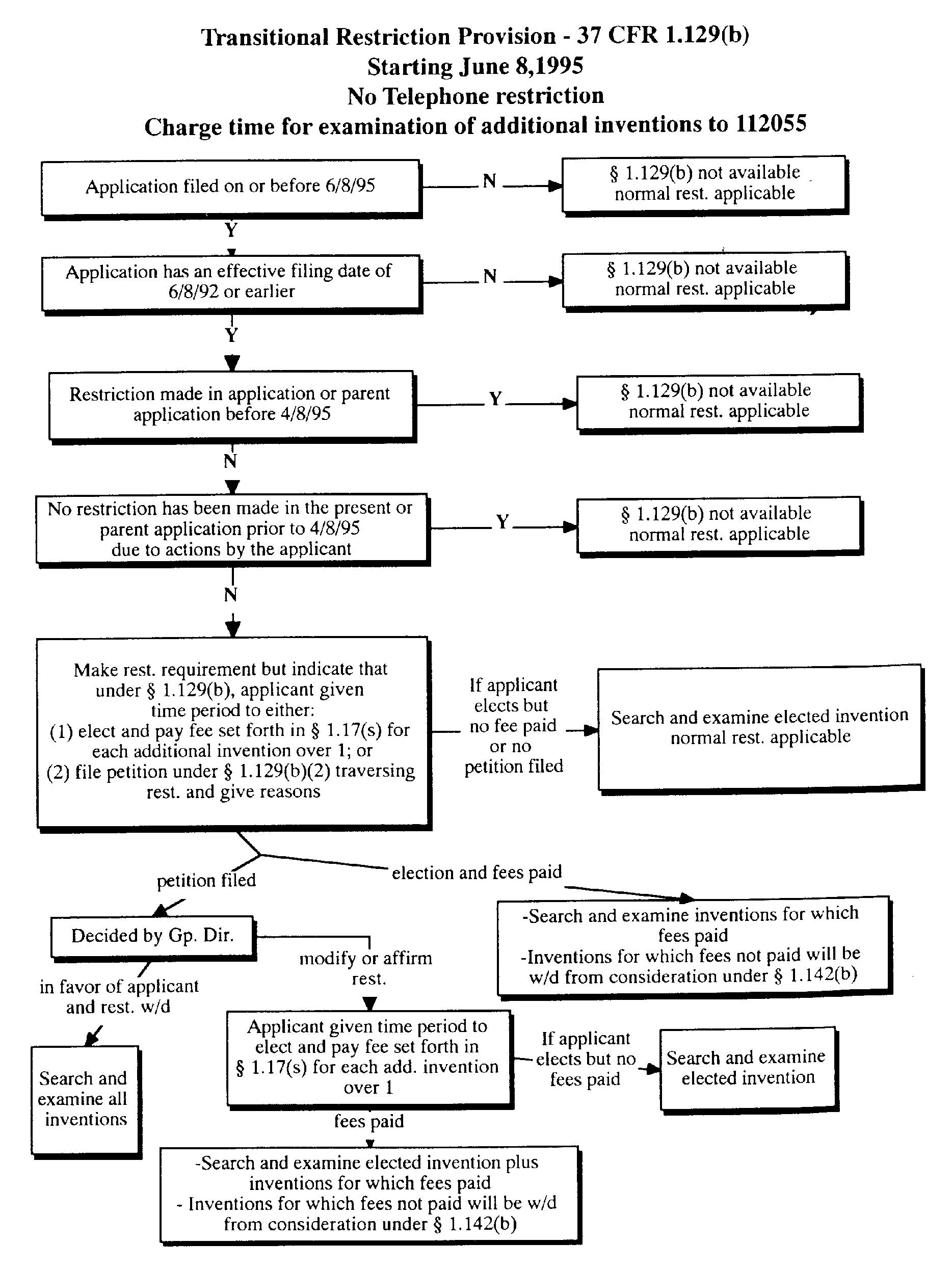
Polynucleotide molecules defined by their nucleic acid sequence (hereinafter "nucleotide sequences") that encode different proteins are structurally distinct chemical compounds. These sequences are thus deemed to normally constitute independent and distinct inventions within the meaning of 35 U.S.C. 121. Absent evidence to the contrary, each such nucleotide sequence is presumed to represent an independent and distinct invention, subject to a restriction requirement pursuant to 35 U.S.C. 121 and 37 CFR 1.141 et seq.
In 1996, the Commissioner of Patents and Trademarks decided sua sponte to partially waive the requirements of 37 CFR 1.141 et seq. and permit a reasonable number of such nucleotide sequences to be claimed in a single application. See Examination of Patent Applications Containing Nucleotide Sequences, 1192 OG 68 (November 19, 1996).
In 2007, the Commissioner for Patents rescinded the waiver. See Examination of Patent Applications Containing Nucleotide Sequences, 1316 OG 123 (March 27, 2007). All pending applications are subject to the 2007 OG notice. Note, however, that supplemental restriction requirements will not be advanced in applications that have already received an action on their merits for multiple nucleotide sequences in the absence of extenuating circumstances. For national applications filed under 35 U.S.C. 111(a), polynucleotide inventions will be considered for restriction, rejoinder, and examination practice in accordance with the standards set forth in MPEP Chapter 800. Claims to polynucleotide molecules will be considered for independence, relatedness, distinction and burden in the same manner as claims to any other type of molecule.
See MPEP § 1850 for treatment of claims containing independent and distinct nucleotide sequences in international applications filed under the Patent Cooperation Treaty (PCT) and national stage applications filed under 35 U.S.C. 371.
*****
Restriction practice relating to reissue applications is governed by 37 CFR 1.176(b) which specifies that restriction may only be required between the invention(s) of the original patent claims and previously unclaimed invention(s) set forth in new claims added in the reissue application. The claims of the original patent must not be restricted as being directed to two or more independent and distinct inventions and must be examined together. Where restriction is required by the examiner, the invention(s) set forth by the original patent claims and any newly added claims that are directed to the same invention(s) will be held as constructively elected. Any new claim that is directed to an invention that is independent and distinct from the invention(s) of the original patent claims will be withdrawn from consideration. See MPEP § 1450 for a detailed explanation of this practice. Note that applicant may initiate a division of the claims by filing more than one reissue application in accordance with 37 CFR 1.177. See MPEP § 1451 for a detailed explanation of this practice.
Where a restriction (including an election of species) requirement was made in an application and applicant permitted the elected invention to issue as a patent without filing a divisional application on the non-elected invention(s) or on non-claimed subject matter distinct from the elected invention, the non-elected invention(s) and non-claimed, distinct subject matter cannot be recovered by filing a reissue application. Once an applicant acquiesces to a restriction (including an election of species) requirement, any invention distinct from that elected and prosecuted to allowance—whether originally claimed or not—can only be pursued in a timely-filed divisional application. A reissue applicant’s failure to timely file a divisional application is not considered to be error causing a patent granted on the elected claims to be partially inoperative by reason of claiming less than the applicant had a right to claim. Accordingly, this is not correctable by reissue of the original patent under 35 U.S.C. 251. In re Watkinson, 900 F.2d 230, 14 USPQ2d 1407 (Fed. Cir. 1990); In re Weiler, 790 F.2d 1576, 229 USPQ 673 (Fed. Cir. 1986). See MPEP § 1412.01.
Whoever invents or discovers any new and useful process, machine, manufacture, or composition of matter or any new and useful improvement thereof, may obtain a patent therefor, subject to the conditions and requirements of this title.
[Editor Note: Applicable to any patent application filed on or after September 16, 2012. See pre-AIA 35 U.S.C. 121 for the law otherwise applicable.]
If two or more independent and distinct inventions are claimed in one application, the Director may require the application to be restricted to one of the inventions. If the other invention is made the subject of a divisional application which complies with the requirements of section 120 it shall be entitled to the benefit of the filing date of the original application. A patent issuing on an application with respect to which a requirement for restriction under this section has been made, or on an application filed as a result of such a requirement, shall not be used as a reference either in the Patent and Trademark Office or in the courts against a divisional application or against the original application or any patent issued on either of them, if the divisional application is filed before the issuance of the patent on the other application. The validity of a patent shall not be questioned for failure of the Director to require the application to be restricted to one invention.
[Editor Note: Not applicable to any patent application filed on or after September 16, 2012. See 35 U.S.C. 121 for the law otherwise applicable.]
If two or more independent and distinct inventions are claimed in one application, the Director may require the application to be restricted to one of the inventions. If the other invention is made the subject of a divisional application which complies with the requirements of section 120 of this title it shall be entitled to the benefit of the filing date of the original application. A patent issuing on an application with respect to which a requirement for restriction under this section has been made, or on an application filed as a result of such a requirement, shall not be used as a reference either in the Patent and Trademark Office or in the courts against a divisional application or against the original application or any patent issued on either of them, if the divisional application is filed before the issuance of the patent on the other application. If a divisional application is directed solely to subject matter described and claimed in the original application as filed, the Director may dispense with signing and execution by the inventor. The validity of a patent shall not be questioned for failure of the Director to require the application to be restricted to one invention.
The doctrine of double patenting seeks to prevent the unjustified extension of patent exclusivity beyond the term of a patent. The public policy behind this doctrine is that:
The public should . . . be able to act on the assumption that upon the expiration of the patent it will be free to use not only the invention claimed in the patent but also modifications or variants which would have been obvious to those of ordinary skill in the art at the time the invention was made, taking into account the skill in the art and prior art other than the invention claimed in the issued patent.
In re Zickendraht, 319 F.2d 225, 232, 138 USPQ 22, 27 (CCPA 1963) (Rich, J., concurring). Double patenting results when the right to exclude granted in one patent is unjustly extended by the grant of another patent or patents. In re Van Ornum, 686 F.2d 937, 943-44, 214 USPQ 761, 766-67 (CCPA 1982).
Some commonality of inventorship or (deemed) ownership must exist between two or more patents or applications before consideration can be given to the issue of double patenting. For example, the patents or applications may have the same inventive entity. The patents or applications may also have at least one common (joint) inventor, which covers the situations where at least one patent or application names a sole inventor and the other patent(s) or application(s) names joint inventors and where all the patents or applications name joint inventors. For example, if one application names inventor A and the second application names joint inventors A and B, then the applications have one common (joint) inventor. As another example, if one application names joint inventors A and B and a second application names joint inventors A, B, and C, then the applications have two common joint inventors, and thus, have at least one common joint inventor. See 35 U.S.C. 100(f) for definition of "inventor" and 35 U.S.C. 100(g) for definition of "joint inventor". Alternatively, the patents or applications may have a common applicant, and/or be commonly assigned/owned or non-commonly assigned/owned but subject to a joint research agreement as set forth in 35 U.S.C. 102(c) or in pre-AIA 35 U.S.C. 103(c)(2) and (3). To determine if subject matter excepted as prior art under 35 U.S.C. 102(b)(2)(C) or disqualified as prior art under pre-AIA 35 U.S.C. 103(c) may be considered for double patenting issues, see MPEP § 804.03.
There are generally two types of double patenting rejections. One is the "same invention" type double patenting rejection based on 35 U.S.C. 101 which states in the singular that an inventor "may obtain a patent." The second is the "nonstatutory-type" double patenting rejection based on a judicially created doctrine grounded in public policy and which is primarily intended to prevent prolongation of the patent term by prohibiting claims in a second patent not patentably distinct from claims in a first patent. Since the doctrine of double patenting seeks to avoid unjustly extending patent rights at the expense of the public, the focus of any double patenting analysis necessarily is on the claims in the multiple patents or patent applications involved in the analysis.
The doctrine of nonstatutory double patenting also seeks to prevent the possibility of multiple suits against an accused infringer by different assignees of patents claiming patentably indistinct variations of the same invention. In re Van Ornum, 686 F.2d 937, 944-48, 214 USPQ 761, 767-70 (CCPA 1982) (citing Chisum, Patents, § 9.04(2)(b) (1981) ). A terminal disclaimer, submitted in compliance with 37 CFR 1.321(c) or (d) to overcome a double patenting rejection, includes a provision that the patent or any patent issuing from the application is only enforceable for and during such period that it is owned by the same party (or parties) that owns the other patents or applications, identified in the terminal disclaimer, that claim obvious variations of one invention. Van Ornum, 686 F.2d at 944-45, 214 USPQ at 767 (citing Chisum, Patents, § 9.04(2)(b) (1981)).
Nonstatutory double patenting includes rejections based on anticipation, a one-way determination of "obviousness," or a two-way determination of "obviousness." It is important to note that the "obviousness" analysis for "obviousness-type" double-patenting is "similar to, but not necessarily the same as, that undertaken under 35 U.S.C. 103." In re Braat, 937 F.2d 589, 592-93, 19 USPQ2d 1289, 1292 (Fed. Cir. 1991) (citing In re Longi, 759 F.2d 887, 892 n.4, 225 USPQ 645, 648 n.4 (Fed. Cir. 1985)); Geneva Pharmaceuticals, 349 F.3d 1373, 1378 n.1, 68 USPQ2d 1865, 1869 n.1 (Fed. Cir. 2003). In addition, nonstatutory double patenting also includes rejections based on the equitable principle against permitting an unjustified timewise extension of patent rights. See In re Schneller, 397 F.2d 350, 158 USPQ 210 (CCPA 1968); see also subsection II.B.6, below.
The charts below are an overview of the treatment of applications having conflicting claims (e.g., where a claim in an application is not patentably distinct from a claim in a patent or another application). Note that although double patenting and unpatentability over prior art are two separate issues (for example, a double patenting reference that contains conflicting claims need not qualify as prior art), the charts speak to both issues when the reference is a patent or application for completeness. Specifically, the charts cover when two applications have claims to the same invention (Charts I-A) or to patentably indistinct inventions (Charts I-B) and when an application and a patent have claims to the same invention (Charts II-A) or to patentably indistinct inventions (Charts II-B). The charts also include first to invent (FTI) versions (i.e., Charts I-A_FTI, I-B_FTI, II-A_FTI, and II-B_FTI) for use when examining an application that is subject to 35 U.S.C. 102 and 103 in effect on March 15, 2013 (e.g., pre-AIA 35 U.S.C. 102 and 103 ) and America Invents Act (AIA) versions (i.e., Charts I-A_AIA, I-B_AIA, II-A_AIA, and II-B_AIA) for use when examining an application that is subject to 35 U.S.C. 102 and 103 in effect on March 16, 2013 (AIA 35 U.S.C. 102 and 103 ). Therefore, in certain situations, examiners may have to use the FTI versions of the charts for an earlier-filed application that is subject to pre-AIA 35 U.S.C. 102 and 103 and the AIA versions of the charts for the later-filed application that is subject to AIA 35 U.S.C. 102 and 103 or vice versa. The charts show possible rejections based upon an earlier-filed application or patent that may be applicable if the record supports such rejections. For example, examiners should determine if an earlier-filed application or patent is prior art under pre-AIA 35 U.S.C. 102(e) or 35 U.S.C. 102(a)(2) before making an anticipation or obviousness rejection based upon the earlier-filed application or patent.
The AIA versions of the charts provide that a (provisional) rejection under 35 U.S.C. 102(a)(2) should not be applied if the earlier-filed application or patent is not prior art in view of 35 U.S.C. 102(b)(2)(A) or (B). The evidence necessary to show that the disclosure is by the inventor or a joint inventor or another who obtained the subject matter disclosed from the inventor or a joint inventor, and is therefore not prior art in view of 35 U.S.C. 102(b)(2)(A), requires a case-by-case analysis, which depends on whether it is apparent from the disclosure itself or the patent application specification that the disclosure is an inventor-originated disclosure. In the situation where a previous public disclosure by the inventor or a joint inventor (or which originated with the inventor or a joint inventor) was not within the grace period but was effective to establish that an intervening disclosure was not 35 U.S.C. 102(a)(2) prior art in view of the exception of 35 U.S.C. 102(b)(2)(B), the previous inventor-originated public disclosure would qualify as prior art under 35 U.S.C. 102(a)(1) and no exception provision could possibly apply. See MPEP §§ 717 et seq. and 2155 et seq. for more information about the prior art exceptions under 35 U.S.C. 102(b)(2).
The AIA versions of the charts do not address the transition cases in which pre-AIA 35 U.S.C. 102(g) applies to applications subject to AIA 35 U.S.C. 102 and 103. See MPEP § 2159.03 to determine if an application is a transition application. Examiners should consult with a Technology Center Practice Specialist if an application is a transition application and the examiner finds potential pre-AIA 35 U.S.C. 102(g) issues.
Finally, the AIA versions of the charts also do not address rejections under 35 U.S.C. 101 and 115 for improper naming of inventor. Although the AIA eliminated pre-AIA 35 U.S.C. 102(f), the patent laws still require the naming of the actual inventor or joint inventors of the claimed subject matter. See 35 U.S.C. 115(a). In the rare situation where there is evidence on the record that the application does not name the correct inventorship, examiners should consult MPEP § 2157 to determine if a rejection under 35 U.S.C. 101 and 115 should be made.
See MPEP § 2258 for information pertaining to double patenting rejections in reexamination proceedings.
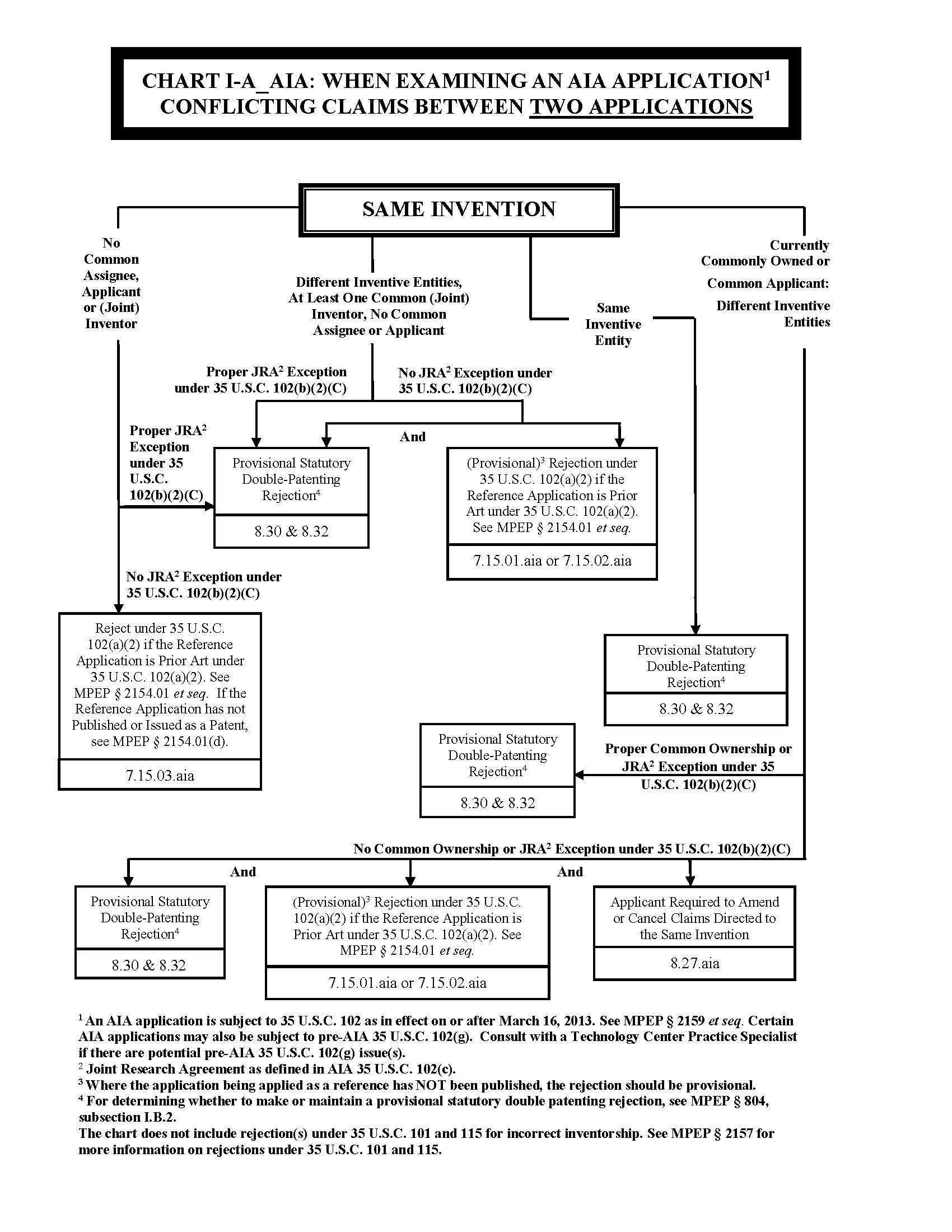
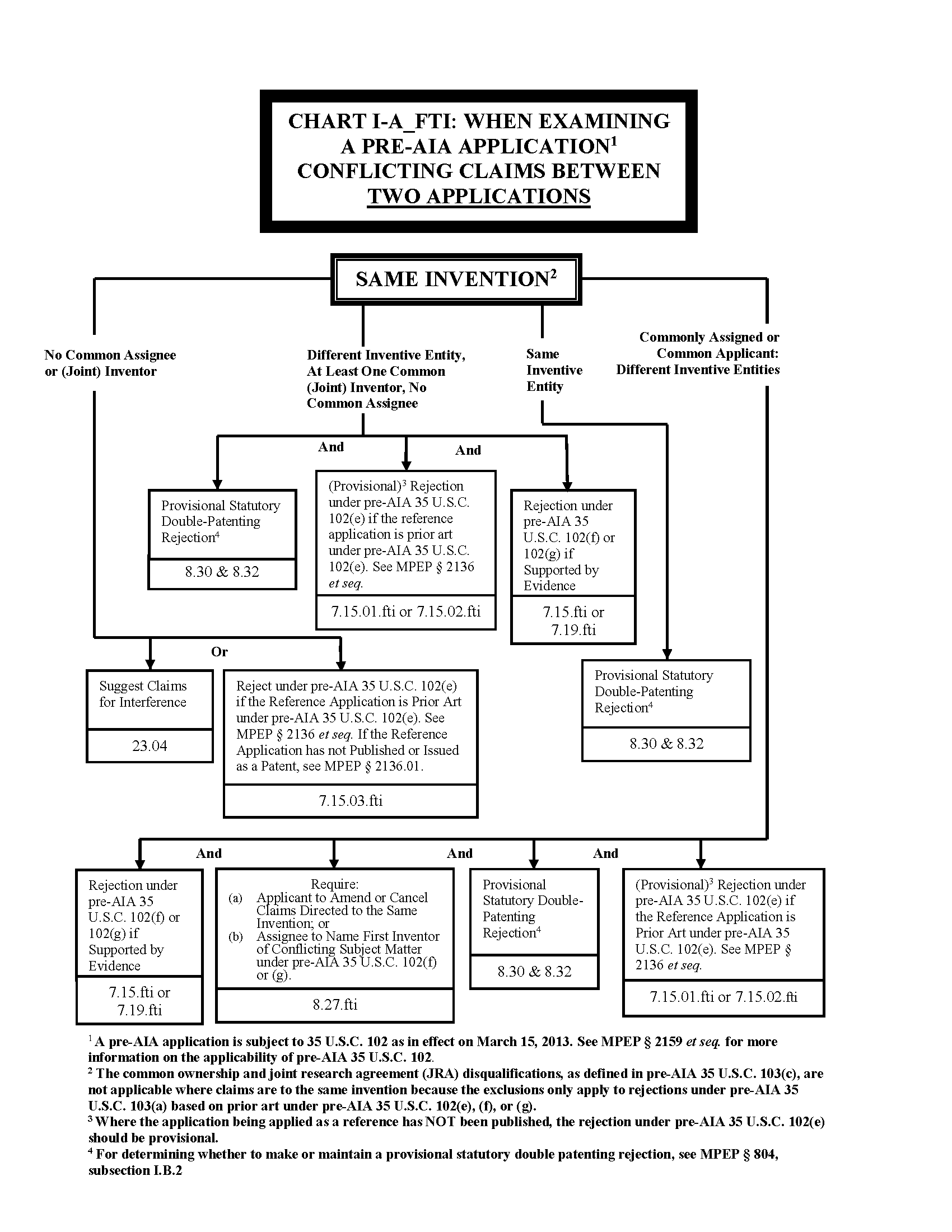

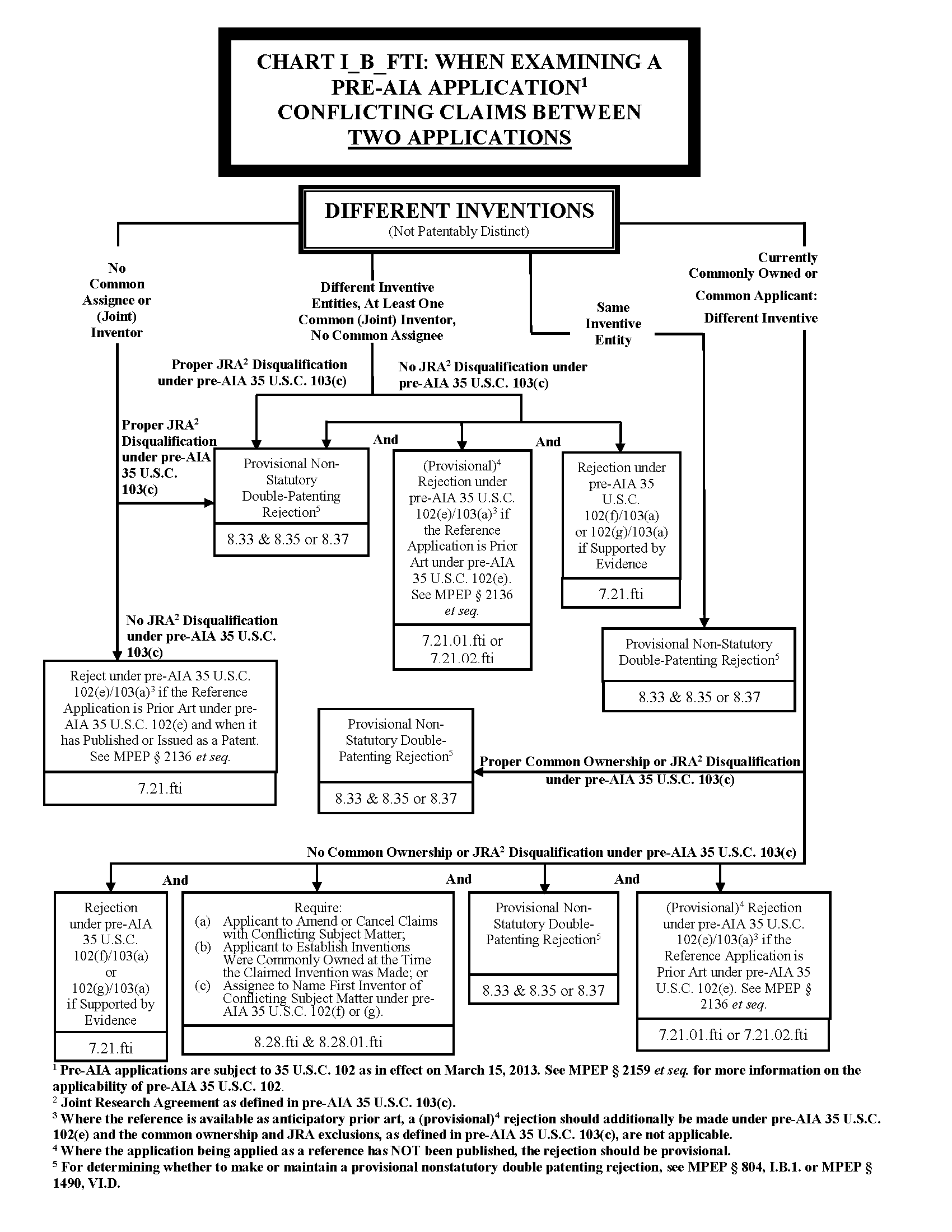
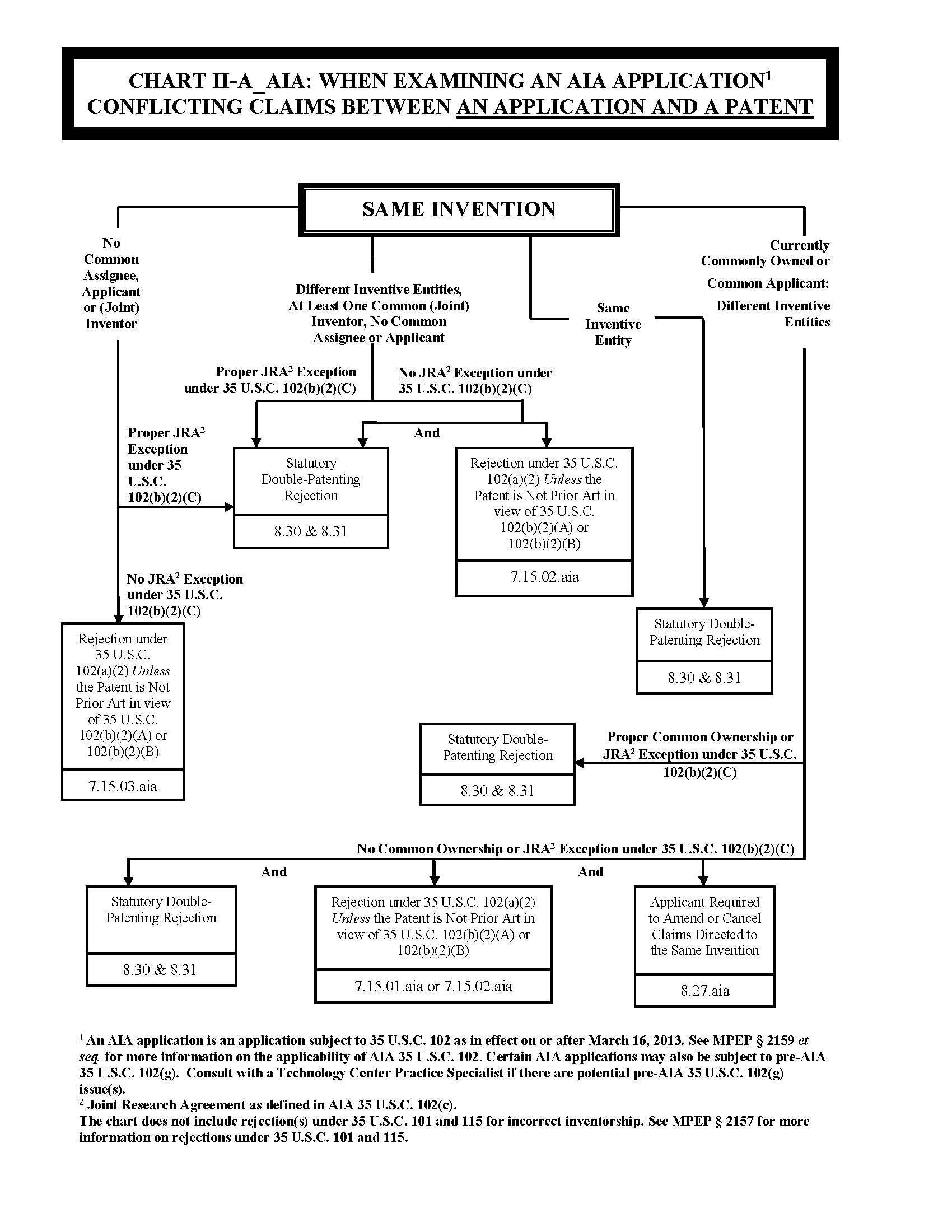
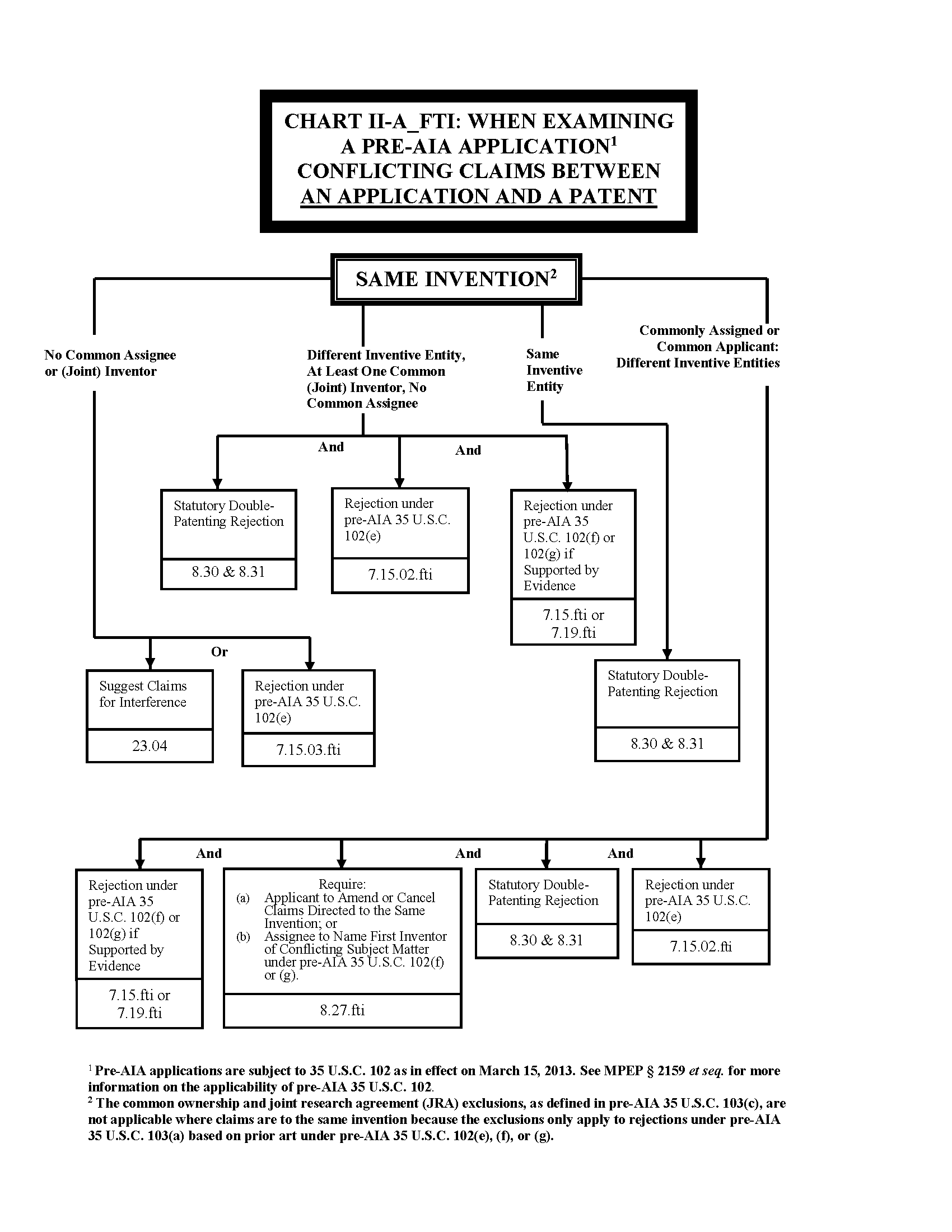
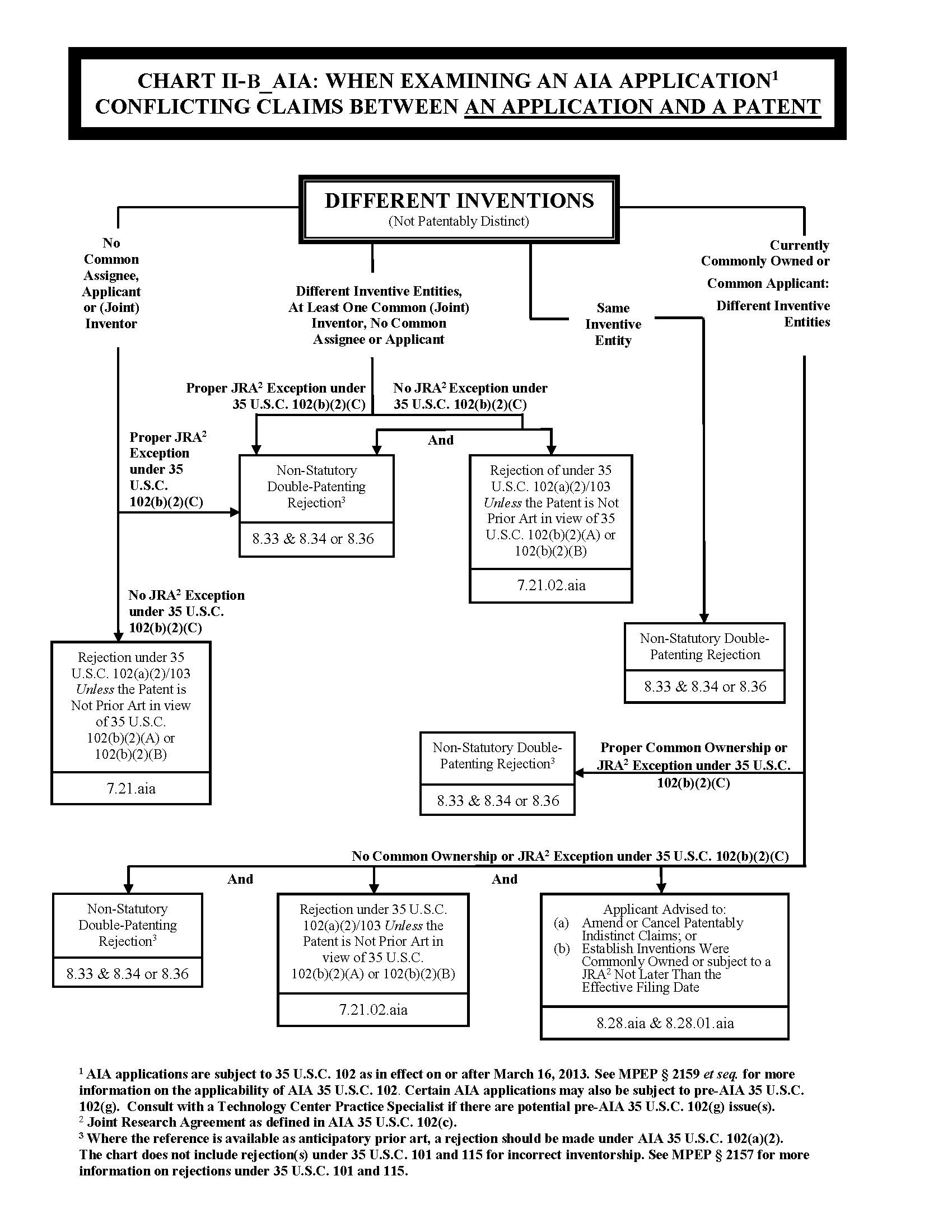
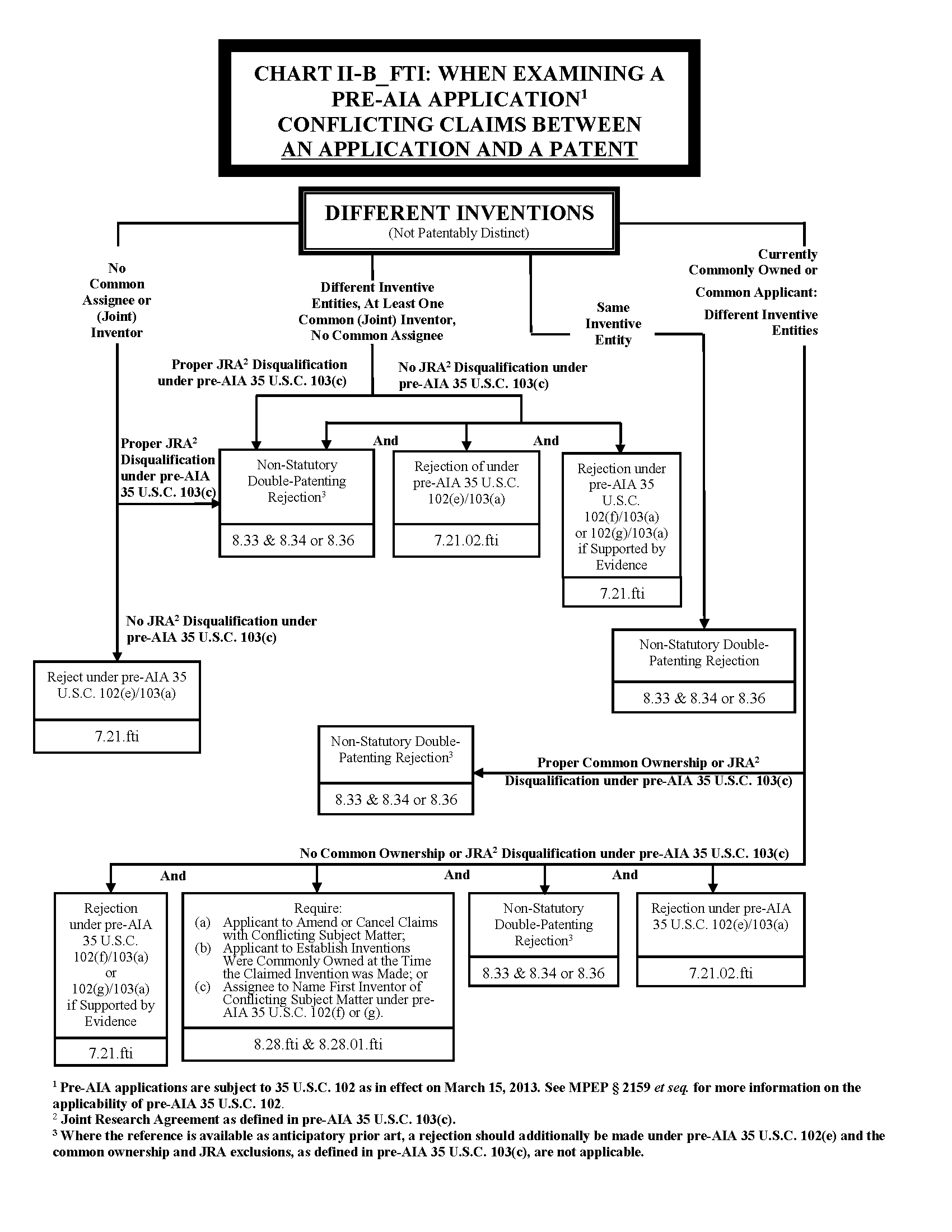
A double patenting issue may arise between two or more pending applications, or between one or more pending applications and a patent. A double patenting issue may likewise arise in a reexamination proceeding between the patent claims being reexamined and the claims of one or more applications and/or patents. Double patenting does not relate to international applications which have not yet entered the national stage in the United States.
Double patenting may exist between an issued patent and an application which share the same inventive entity, at least one common (joint) inventor, a common applicant, and/or a common owner/assignee. See In re Hubbell, 709 F.3d 1140, 1146-47, 106 USPQ2d 1032, 1037-38 (Fed. Cir. 2013) (in the context of an application and a patent that had two common joint inventors, but different inventive entities and no common owners or assignees, the court held that complete identity of ownership or inventive entities is not a prerequisite to a nonstatutory double patenting rejection). Double patenting may also exist where the inventions claimed in a patent and an application were made as a result of activities undertaken within the scope of a joint research agreement as defined in 35 U.S.C. 102(c) or pre-AIA 35 U.S.C. 103(c)(2) and (3). Since the inventor/applicant/patent owner has already secured the issuance of a first patent, the examiner must determine whether the grant of a second patent would give rise to an unjustified extension of the rights granted in the first patent.
An examiner may become aware of two or more copending applications which share the same inventive entity, at least one common (joint) inventor, a common applicant, and/or a common owner/assignee, or that claim an invention resulting from activities undertaken within the scope of a joint research agreement as defined in 35 U.S.C. 102(c) or pre-AIA 35 U.S.C. 103(c)(2) and (3), that would raise an issue of double patenting if one of the applications became a patent. Where this issue can be addressed without violating the confidential status of applications (35 U.S.C. 122 ), the courts have sanctioned the practice of making applicant aware of the potential double patenting problem if one of the applications became a patent by permitting the examiner to make a provisional rejection on the ground of double patenting. In re Mott, 539 F.2d 1291, 190 USPQ 536 (CCPA 1976); In re Wetterau, 356 F.2d 556, 148 USPQ 499 (CCPA 1966). An application that was published under 35 U.S.C. 122(b) without redactions can be utilized as a double patenting reference without violating the confidential status required by 35 U.S.C. 122. An unpublished application, or an application that has been published as redacted, can be utilized as a double patenting reference without violating the confidential status required by 35 U.S.C. 122 when it has at least one common (joint) inventor, applicant, assignee, or owner, or is deemed commonly owned (35 U.S.C. 102(c) or pre-AIA 35 U.S.C. 103(c)(2) ) with the application under examination. See MPEP §§ 2136.01 and 2154.01(d) for information on provisional rejections based on prior art. The merits of such a provisional rejection can be addressed by both the applicant and the examiner without waiting for the first patent to issue.
A provisional double patenting rejection should be made and maintained by the examiner until the rejection has been obviated or is no longer applicable except as noted below.
A complete response to a nonstatutory double patenting (NSDP) rejection is either a reply by applicant showing that the claims subject to the rejection are patentably distinct from the reference claims, or the filing of a terminal disclaimer in accordance with 37 CFR 1.321 in the pending application(s) with a reply to the Office action (see MPEP § 1490 for a discussion of terminal disclaimers). Such a response is required even when the nonstatutory double patenting rejection is provisional.
As filing a terminal disclaimer, or filing a showing that the claims subject to the rejection are patentably distinct from the reference application’s claims, is necessary for further consideration of the rejection of the claims, such a filing should not be held in abeyance. Only compliance with objections or requirements as to form not necessary for further consideration of the claims may be held in abeyance until allowable subject matter is indicated. Replies with an omission should be treated as provided in MPEP § 714.03. Therefore, an application must not be allowed unless the required compliant terminal disclaimer(s) is/are filed and/or the withdrawal of the nonstatutory double patenting rejection(s) is made of record by the examiner. See MPEP § 804.02, subsection VI, for filing terminal disclaimers required to overcome nonstatutory double patenting rejections in applications filed on or after June 8, 1995.
If two (or more) pending applications are filed, in each of which a rejection of one claimed invention over the other on the ground of provisional nonstatutory double patenting (NSDP) is proper, the provisional NSDP rejection will be made in each application. Where there are three applications containing claims that conflict such that a provisional NSDP rejection is made in each application based upon the other two, and it is necessary to file terminal disclaimers to overcome the rejections, it is not sufficient to file a terminal disclaimer in only one of the applications addressing the other two applications. Rather, an appropriate terminal disclaimer must be filed in at least two of the applications to require common ownership or enforcement for all three applications. A terminal disclaimer may be required in each of the three applications in certain situations. See subsections (a)-(c) below. See also MPEP § 1490, subsection VI.D.
The doctrine of double patenting seeks to prevent the unjustified extension of patent exclusivity beyond the term of a patent. For utility and plant patents issuing on applications filed on or after June 8, 1995, 35 U.S.C. 154(a)(2) provides that the patent term ends on the date that is twenty years from the date on which the application for the patent was filed in the United States, or if the application contains a specific reference to one or more earlier-filed application(s) under 35 U.S.C. 120, 121, 365(c), or 386(c), twenty years from the filing date of the earliest such application. For a patent that issues on an international (PCT) application that entered the national stage under 35 U.S.C. 371, the date that the application was filed in the United States is the international filing date; see MPEP § 2701, subsection II. Thus, where there are two or more original applications (applications which are not reissue applications - see MPEP § 201.02) with conflicting (i.e., patentably indistinct) claims, it may be necessary to determine the respective date from which the twenty year term is measured in view of 35 U.S.C. 154(a)(2) (hereinafter referred to as the "patent term filing date") for each of the applications which could potentially issue as patents.
The patent term filing date of an original utility or plant application filed on or after June 8, 1995 is the earliest of:
For example, if an original (non-reissue; see MPEP § 201.02) patent application has no specific reference to any earlier-filed application under 35 U.S.C. 120, 121, 365(c), or 386(c), then the patent term filing date is the date that the application was actually filed. However, if an original patent application does include one or more specific references to an earlier-filed application under 35 U.S.C. 120, 121, 365(c), or 386(c), then the patent term filing date is the filing date of the earliest reference application for which the benefit is properly claimed. See MPEP § 2701. For an application to properly claim the benefit of an earlier-filed application, it must meet the requirements of 37 CFR 1.78 (e.g., having a (joint) inventor in common, copendency, timeliness, and a proper reference). See 37 CFR 1.78 and MPEP § 211.01 et seq. It does not require a determination that the earlier-filed application discloses the invention in a manner provided by 35 U.S.C. 112(a). In other words, the issue of entitlement of a claimed invention to the benefit of the filing date of an earlier-filed application does not affect the expiration date of a patent containing the claims, and therefore need not be considered when determining the patent term filing date for the purpose of a double patenting analysis.
The patent term filing date of a reissue application for purposes of nonstatutory double patenting analysis is the patent term filing date of the original application that resulted in the patent for which reissue is sought.
Benefit claims under 35 U.S.C. 119(e) and foreign priority claims under 35 U.S.C. 119(a)-(d) or (f), 365(a) or (b), or 386(a) or (b) are not taken into account when determining the term of an issued patent (see 35 U.S.C. 154(a)(2) and (a)(3) ), and therefore, are not taken into account in determining the patent term filing date of an application.
Subsections (i)-(iv) below discuss examination procedures when two or more utility or plant patent applications, filed on or after June 8, 1995, contain provisional nonstatutory double patenting rejections over each of the other application(s). The explanations refer to pairs of applications, but also apply when more than two applications are involved.